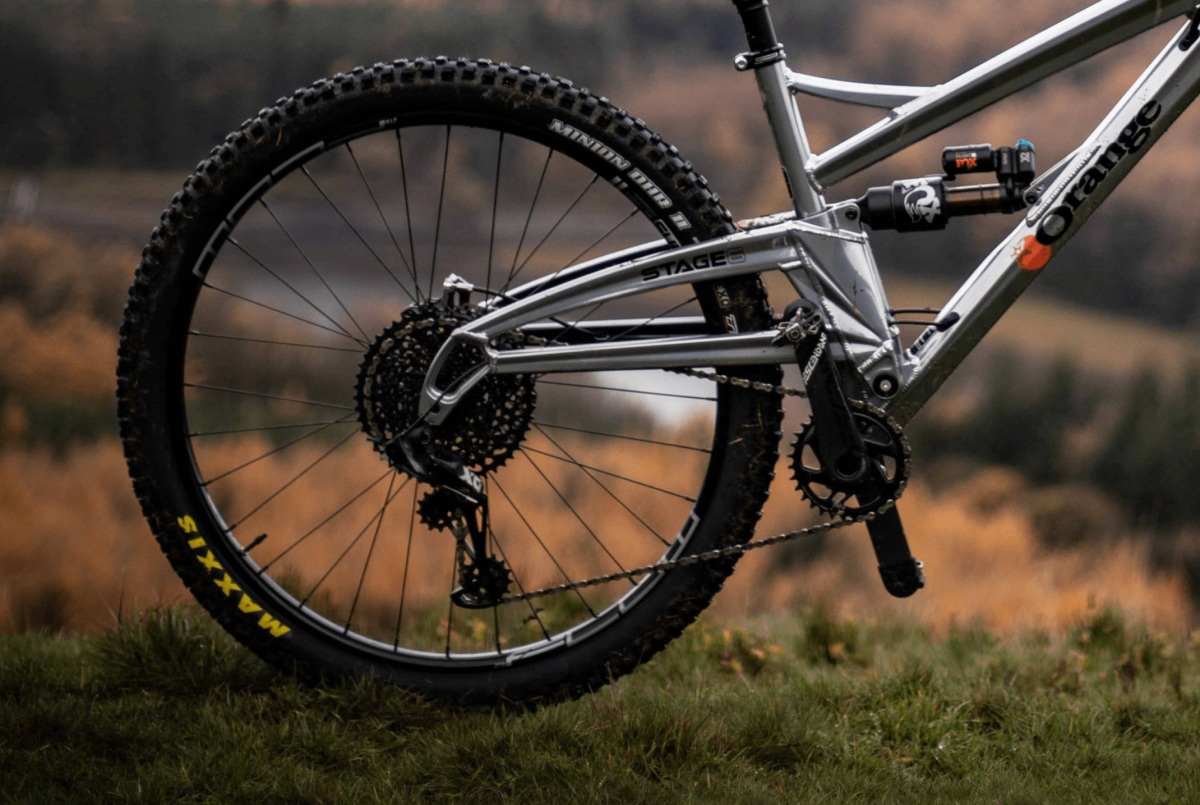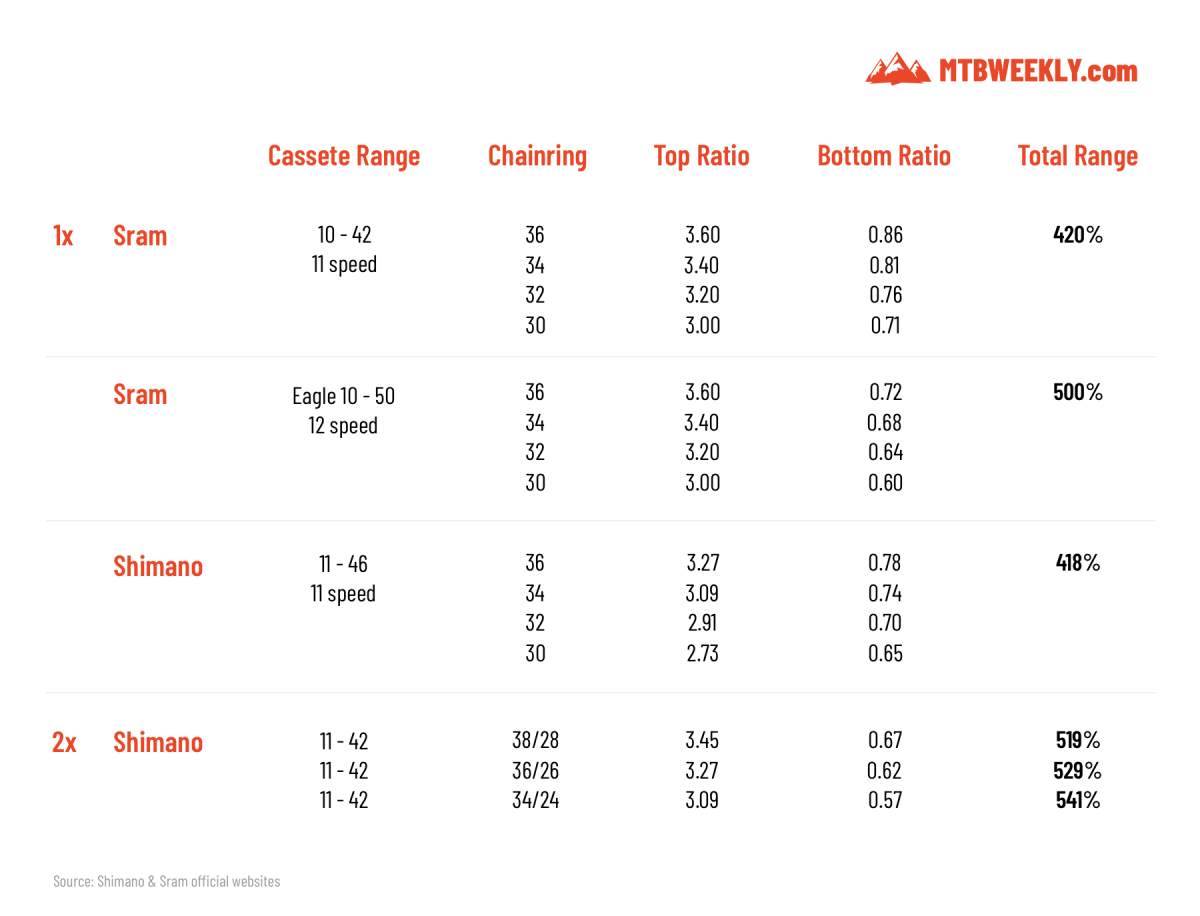When buying my latest bike, I had to choose between a 2x and 1x drivetrain. With almost all manufacturers offering both options in their lineup, it’s another hard choice you must make. So which one is better, a 1x or 2x drivetrain?
The short answer is - it depends. It comes down to the type of rider you are and the terrain you will be riding most. 2x gives you a wmore comprehensiverange and makes it easier to tackle steep climbs, while the 1x is much easier to operate and is less prone to chain drops. Let’s look at both options uo find out which one is right for you.
What does 1x and 2x mean?
The number refers to the number of gears you have. For example, a 1x11 drivetrain will have 1 gonear in the front and 11 in the back.

Why chose a 1x drivetrain?
The main advantage of 1x can be summed up in one word — simplicity. Because you only have a rear derailleur, you can free up space on your handlebars and use it instead for a dropper post lever. You shift gears with one hand, leaving the other free to drop your post, break or just enjoy an energy bar.
The most significant advantage is that a 1x drivetrain lets you focus on your ride by constantly adjusting gears. It’s also less likely that your chain will drop off the front since it’s fixed to one chain ring.
All this does come at a price. There is a noticeable drop between gears, meaning you might not be able to find the right gear every time. You also have less range on a 1x setup. This means that you might be riding in a harder gear up a steep hill than you’d like and space savings, shifting with one hand, less prone to chain drops, and easier for new riders
Cons: smaller range of gears making it harder to climb steep ascents; bigger drops between gears make it hard to find the optimal gear
Why is 1x so popular these days?
1x has gained much popularity among riders in the last few years. Fueled by the rise of Enduro racing and technological advances, it is possible to attain a working 1x setup. But the 2x system still has a lot of fans. In fact, Shimano surveyed recently and discovered that it’s really 50/50 among riders.
However, I ran a small survey in the r/mountianbiking subreddit and the results were more in favor of 2x, again just showing there is no clear winner.

Why choose a 2x drivetrain?

If what you are after is better performance on climbs, a 2x is a better option. The main advantage of having a front derailleur is the wide gear range it offers and a smoother transition between gears. The end result is an easier climb on steep ascents. It also gives you more confidence to explore and tackle unknown terrain.
The disadvantage is the extra complexity that a front derailleur introduces. For starters, you have an extra lever to think about and adjust. It also creates extra clutter and adds weight to your bike. You also run a higher risk of chain drops with this setup. This can be minimized by adding a chain guide, but again — that’s more weight and complexity. You also need to tune and maintain an additional derailleur.
Pros: Better gear range and smoother gear transitions, resulting in better climbing performance.
Cons: Extra complexity with the maintenance of the front derailleur, additional gear shifter on handlebars, and a higher chance of chain drops.
To get a better idea of the gear range 2x offers, let's compare it to popular 1x setups:

Which drivetrain manufacturer is better?
There are a lot of drivetrain manufacturers, but the biggest by far are Sram and Shimano. If you are buying a mountain bike from any major brand, they will offer both Shimano and Sram options. So what’s the difference?
First off, I think it’s great we have two big names in the game. The end result is constant competition and pushing what’s technologically possible. We benefit every time.
There are a few differences between Sram and Shimano. Most noticeably in the shifting actuation, meaning the distance between shifts in relation to the lever index.
Shimano has a 1:1 ratio — the cable and derailleur move further between shifts. The end result is crisper shifting with a better feel and sturdiness in muddy terrain.
Sram, on the other hand, has a 2:1 ratio, which creates smoother shifts with less effort.
The second difference is in the way you shift. Shimano lets you shift with both your thumb and your forefinger, whereas Sram is thumb-operated only. Sram also offers Gripshift with all their setups, letting you shift gears by turning the handlebar grip. It’s available throughout the range and is very popular with performance riders.
Sram is committed to the 1x setup and has only a few 2x options left in the low-end spectrum of their lineup. Shimano still offers 2x setups in their high-end and flagship lineup.
Day-to-day life with Sram & Shimano
There’s more to it than just ratio difference. I tried to outline a few differences that matter in day-to-day life:
- Sram is easier for unmounting the rear wheel: Sram has a unique system that allows you to lock the rear derailleur effectively removing all the tension from the chain and making it easy to unmount the rear wheel.
- Sram has a positive click: when you shift on a Sram system, you will hear a loud click - some riders like the “positive” click sound, giving them a better connection with their bike.
- Shimano lets you shift 2 gears at a time: when going to a harder gear, Shimano lets you shift 2 gears at a time. Sram can only shift 1 gear at a time going to a harder gear. Both systems let you shift multiple gears when going down.
- Shimano makes it easier to change the derailleur cable: If you are doing your own cable maintenance, Shimano has easier access to the cable housing and is simpler to work on.
Don’t get me wrong — both systems are great. There are small nuances that make them different, and it’s really up to you, which one hits closer to home. Let me know in the comments which is your favorite and why!
Understanding the lineup
Both manufacturers have a different approach to their lineups. Sram is usually the more progressive brand, bringing innovation to market sooner, while Shimano has more options on the higher end of the spectrum.

What’s the future of drivetrains?
Technology is making its way into every part of mountain biking, and drivetrains are no different. The two main manufacturers, Shimano and Sram, are fighting this one off with two different approaches to electronic drivetrains.
Synchro shifting from Shimano
Shimano’s approach is the Di2 system, which comes in 3 flavors: It can be a 1x11 setup that operates the rear derailleur electronically rather than with a cable-actuated system or a 2x11 system with individual controls for the front and the rear derailleur. Shimano also offers their Synchro Shift system — a 2x11 that combines the simplicity of a 1x system with the range of a 2x one, bringing the best of both worlds. It does this by automatically adjusting the front derailleur based on the gear you choose in the back.
Wireless shifting from Sram
Sram has taken a different route with the just announced Eagle AXS system — a fully wireless electrical drivetrain. It’s a 1x12 setup that completely removes the clutter since there are no cables to run.
Conclusion
As with many other things in mountain biking (or life in general), it really comes down to your personal choice. If you are a rider that enjoys climbs and will seek steep hills to climb a 2x drivetrain is a better option for you. If you endure the climb up only to shred downhill, the 1x is a wiser choice. Whatever you pick, don’t forget to enjoy every ride, because that’s what it’s about!



